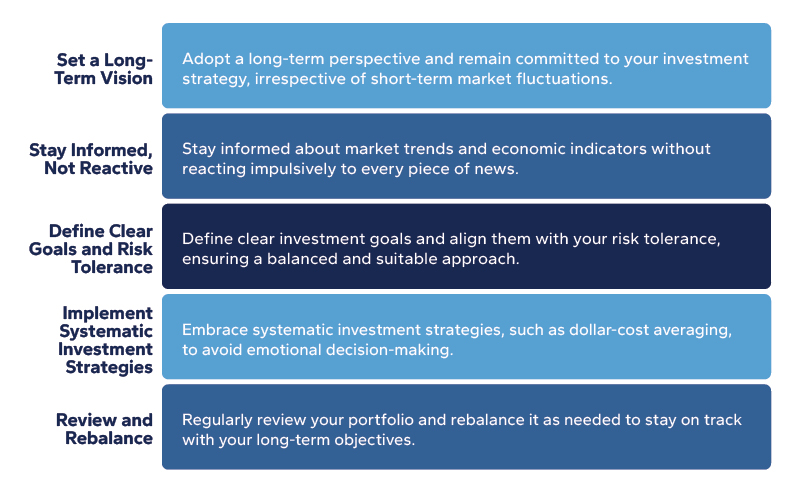Key Takeaways
- The best way to withstand market volatility is to have a portfolio you won’t lose confidence in—even during the worst of times.
- Feelings of fear, greed, excitement, and panic can lead to decisions that may not align with sound investment strategies.
- Cash is a popular investment strategy right now—with investors moving $508 billion into cash funds in the first quarter of 2023.
Investing is a powerful tool that may help your money grow and work for you. Unlike the stagnant nature of traditional savings, appropriately selected investments can offer the potential for growth, capital appreciation, and the ability to outpace inflation.
However, it is crucial to approach investing with a balanced perspective—one that considers time horizon, financial goals, and risk tolerance. While strategic investing requires careful consideration and a comprehensive understanding of your unique financial situation, there are some foundational lessons every investor can utilize.
Lesson 1: You can invest more strategically if you know why you’re investing.
In order to invest effectively, it’s important to understand why you’re investing in the first place. Ask yourself: “What am I hoping to achieve with my wealth?”
Research published in the Financial Analysts Journal indicates that over 90% of investment performance is related to investment policy (identifying goals and allocating your portfolio into a mix of assets that aligns with those goals), while investment strategy (the specific investments chosen and timing the market) account for less than 10% of the equation.
The primary objective of goal-based planning is to help you achieve your specific financial aspirations, such as buying a house, saving for retirement, funding education, starting a business, or passing wealth to the next generation. It tailors the financial planning process to your unique circumstances, considering factors like age, income, time left to complete your goals, and ability and willingness to accept risk.
Lesson 2: Managing your emotions is crucial to an effective investment strategy.
Investing is inevitably emotional—it involves entrusting your hard-earned money to uncertain markets with no guarantee of returns. Fear, greed, excitement, and panic often intertwine, which left unchecked may lead to decisions that are not aligned with sound investment strategies.
To navigate the unpredictable waters of the financial markets, try to cultivate a rational investor mindset. This involves the following key principles:

For many investors, the emotional aspect of decision-making can be challenging to overcome on their own. Seeking the guidance of a financial advisor can provide invaluable support in maintaining discipline, developing rational strategies, and avoiding emotional pitfalls.
Lesson 3: Be wary of trying to time the market.
The allure of market timing is an age-old temptation for investors seeking to maximize returns and avoid losses. However, the market can go up as quickly as it can go down. Experiencing volatility is part of the cost of investing. Keeping your cash invested throughout the fluctuations is what helps your money grow—and compound—over time.
In order to successfully time the market, you need to do it twice—you need to be able to put your money in at the right time and take it out at the right time. This is extremely difficult, even for experienced investors.
Rather than focusing your attention on market timing, it’s better to develop a portfolio that can withstand inevitable fluctuations. The best way to withstand market volatility is to have a portfolio you won’t lose confidence in—even during the worst of times.

Lesson 4: Diversification is key to long-term market stability.
Diversification involves spreading investments across a range of different asset classes, geographic regions, and investment vehicles in order to minimize overall risk as much as possible. The fundamental idea is simple: not putting all your eggs in one basket.
In the dynamic landscape of investing, diversification can act as a powerful shield against market turbulence. When one asset class experiences a decline, the impact may be cushioned by the positive performance of other components in the portfolio. This risk reduction can help stabilize the portfolio, providing a smoother journey through market ups and downs.
Diversification may encompass a broad array of asset classes, such as stocks, bonds, real estate, commodities, and cash, among others. Certain asset classes react differently to economic conditions, allowing investors to balance risk and return.
Lesson 5: Cash is a popular investment strategy right now—but it may not stay that way.
Trends come and go quite frequently in the investment world. Right now, cash is sitting on the front lines of many investment strategies.
According to a recent Allianz research report, 62% of Americans surveyed said they would rather keep their money in cash than weather the market storm. Recent bank failures have also caused investors to move their money to more conservative, low-risk accounts and funds.
In the first quarter of 2023, investors moved $508 billion into cash funds, according to Bank of America's global research.
Cash investments can offer a sense of security and liquidity, but it's essential to understand the opportunity cost associated with this strategy and recognize that it may not remain the most favorable option.
For example, in periods of economic expansion and favorable market conditions, other investment options tend to outperform cash investments. Consequently, investors who have chosen to stay in cash may miss out on significant growth opportunities in more lucrative asset classes.
While cash investments may provide short-term stability, their long-term growth potential is limited. As economic conditions change, market cycles evolve, and interest rates fluctuate, the attractiveness of cash as an investment strategy may diminish.
Investing for Today’s Needs and Tomorrow’s Goals
Investing is not merely about amassing wealth; it represents an empowering journey of discovery, resilience, and achieving personal goals. Whether it is the dream of a comfortable retirement, providing for a child's education, or embarking on a new venture, investing serves as a catalyst that can turn these goals into achievable milestones.
Eide Bailly’s investment philosophy focuses on comprehensive financial planning across your entire financial life. It’s about more than just investments—it’s strategizing to minimize taxes while adjusting tactics to align with your personal risk tolerance and changing market climates.
The Pros and Cons of ESG Investing

Investment Solutions
Eide Bailly can help you create a customized investment strategy.

